Note: Our trip to Greece is so breathtaking that we needed to split it into four-and-a-half blog posts to cover it all. This is part three. You can skip ahead to parts four or the epilogue, if you'd like, or you can go back to parts one or two. But take your time--it's really beautiful!
Crete has a tumultuous history, as I indicated in my previous post. Before all those conquests, though, there were the more than 1000 years of (relative) peace and prosperity of the Minoan period. Lasting from about 2700 through 1400 BC, Minoan Crete was Europe's first great civilization. I got to see three different places with significant Minoan stuff--the Archaeological Museum in Heraklion, the palace at Malia, and the palace at Knossos.
The Archaeological Museum was amazing because I got to see in person several artifacts I recognized from textbooks. I managed to restrain myself from photographing every single item in the museum, but just barely.
Here's an artifact you'll probably recognize: the famous Bee Pendant. Apparently the craft for producing those tiny balls of gold in the middle has been lost. Humans don't know how to do that any more, but the Minoans figured out how to do it 1500 years before the birth of Christ.

There was tons of cool pottery, but this piece is probably my favorite.
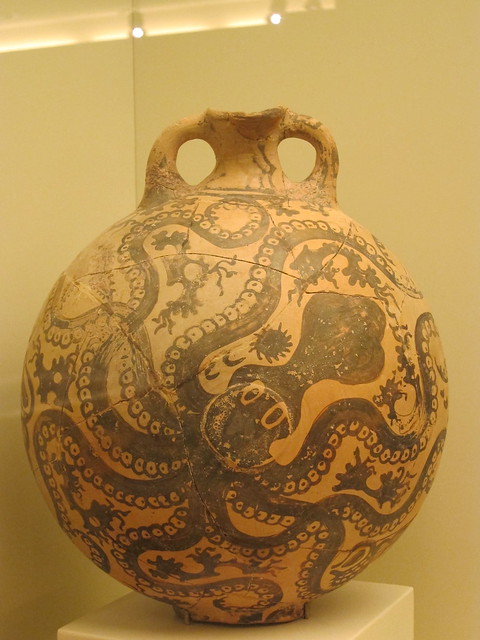
I couldn't resist including this Minoan board game.
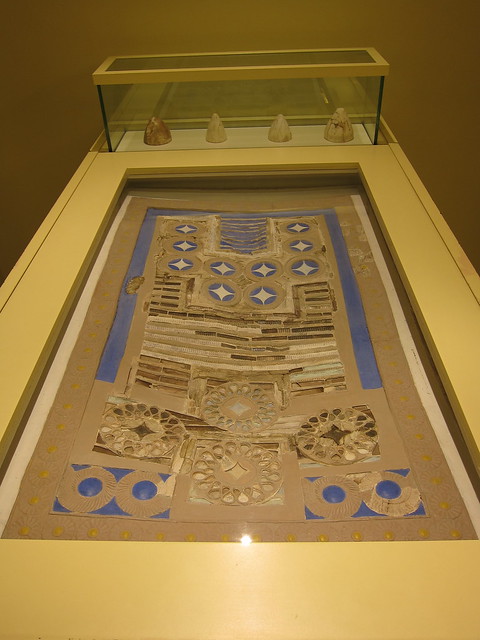
I recognized this guy, too. It turns out he's a very fancy drinking vessel.
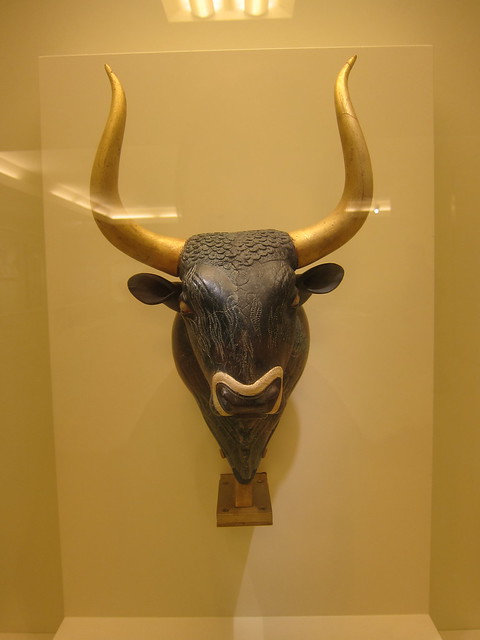
The Minoans were into extreme sports. This fresco shows a man bull jumping--doing a somersault on the back of a bull.
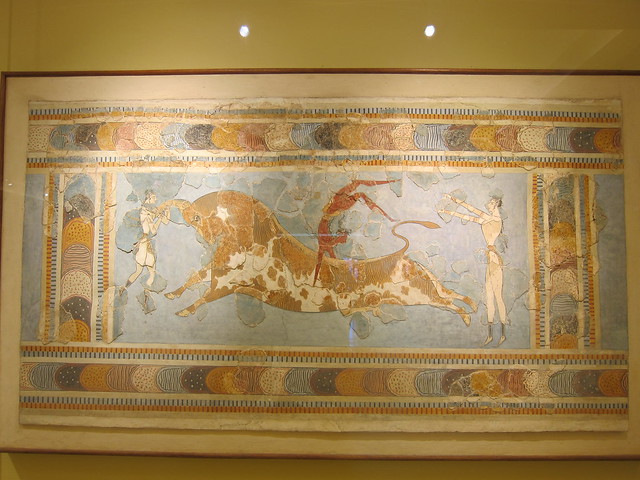
Probably most famous of all, the Phaistos Disc! Both sides are covered with hieroglyphics that spiral into the center. Notice the prehistoric mohawk.
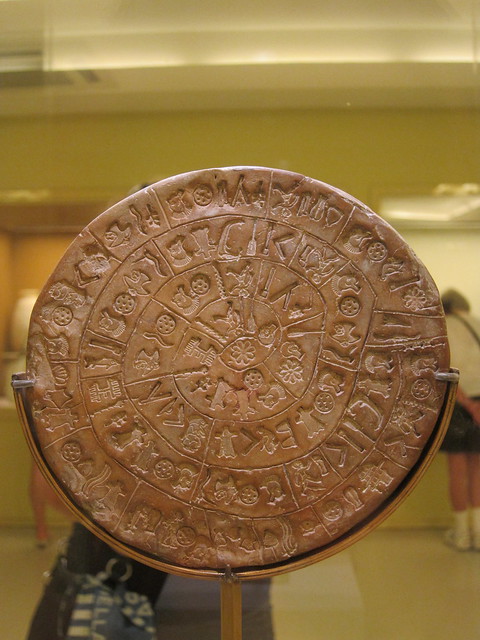
In addition to a writing system that still hasn't been deciphered (known as Linear A), the Minoans had great taste in jewelry.
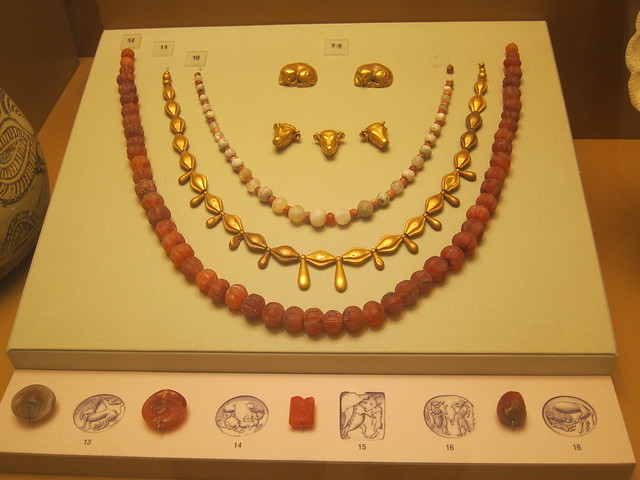
As part of our excursion on Saturday we went to the ruins of the palace of Malia, where we listened for a very long time to our tour guide talk about storage of various foodstuffs, multiple theories for the use of each room in the palace, and the opposing archaeological philosophies of the British/Americans and the French/Greeks. I got the sense that, though the excavators at Knossos in fact made some questionable choices in their restorations there (more on this later), the French and Greeks are mostly pissed because the Brits and Americans got the cooler site. Not that Malia isn't cool--it is, and you're allowed to climb everywhere, so in some ways it's more fun than Knossos. But there was way more left to find at Knossos, including frescoes, walls made of sparkly stone, an actual throne, and rooms with multiple stories.
Without further ado, the palace of Malia.
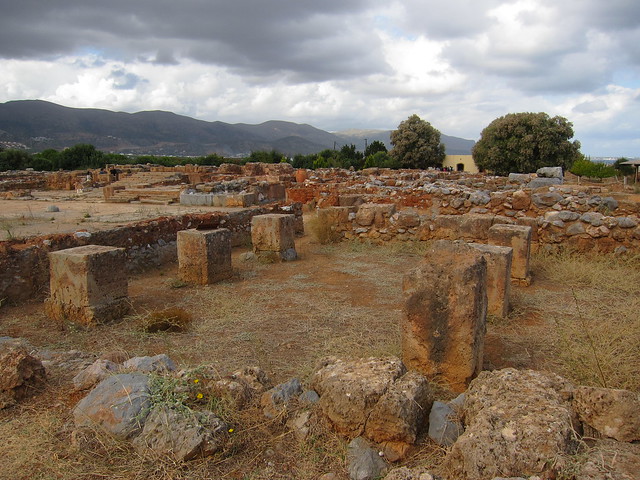
Nice backdrop, huh?
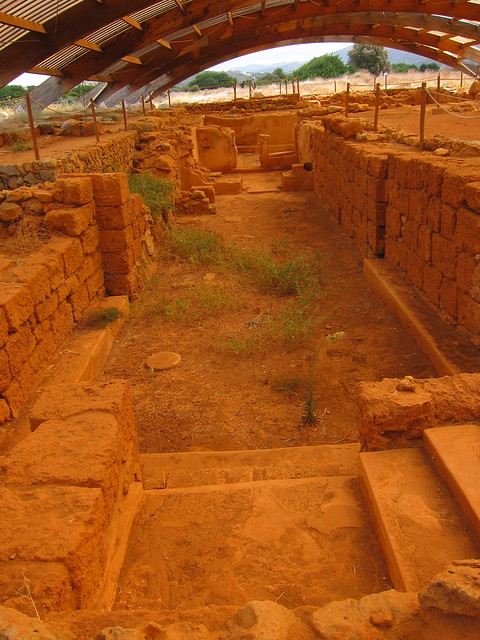

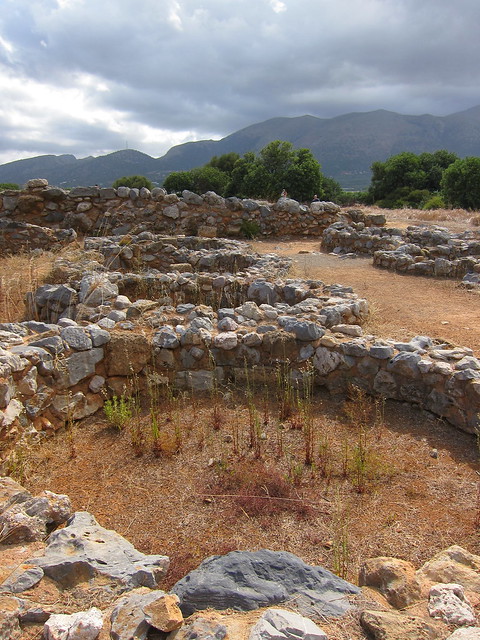
Crete has a tumultuous history, as I indicated in my previous post. Before all those conquests, though, there were the more than 1000 years of (relative) peace and prosperity of the Minoan period. Lasting from about 2700 through 1400 BC, Minoan Crete was Europe's first great civilization. I got to see three different places with significant Minoan stuff--the Archaeological Museum in Heraklion, the palace at Malia, and the palace at Knossos.
The Archaeological Museum was amazing because I got to see in person several artifacts I recognized from textbooks. I managed to restrain myself from photographing every single item in the museum, but just barely.
Here's an artifact you'll probably recognize: the famous Bee Pendant. Apparently the craft for producing those tiny balls of gold in the middle has been lost. Humans don't know how to do that any more, but the Minoans figured out how to do it 1500 years before the birth of Christ.

There was tons of cool pottery, but this piece is probably my favorite.

I couldn't resist including this Minoan board game.

I recognized this guy, too. It turns out he's a very fancy drinking vessel.

The Minoans were into extreme sports. This fresco shows a man bull jumping--doing a somersault on the back of a bull.

Probably most famous of all, the Phaistos Disc! Both sides are covered with hieroglyphics that spiral into the center. Notice the prehistoric mohawk.

In addition to a writing system that still hasn't been deciphered (known as Linear A), the Minoans had great taste in jewelry.

As part of our excursion on Saturday we went to the ruins of the palace of Malia, where we listened for a very long time to our tour guide talk about storage of various foodstuffs, multiple theories for the use of each room in the palace, and the opposing archaeological philosophies of the British/Americans and the French/Greeks. I got the sense that, though the excavators at Knossos in fact made some questionable choices in their restorations there (more on this later), the French and Greeks are mostly pissed because the Brits and Americans got the cooler site. Not that Malia isn't cool--it is, and you're allowed to climb everywhere, so in some ways it's more fun than Knossos. But there was way more left to find at Knossos, including frescoes, walls made of sparkly stone, an actual throne, and rooms with multiple stories.
Without further ado, the palace of Malia.

Nice backdrop, huh?



I went to Knossos by myself on Tuesday, our last full day on Crete. It's a little way outside the city of Heraklion, and can be reached by a (mercifully) cheap bus.
Here is one of the iconic shots of the palace:
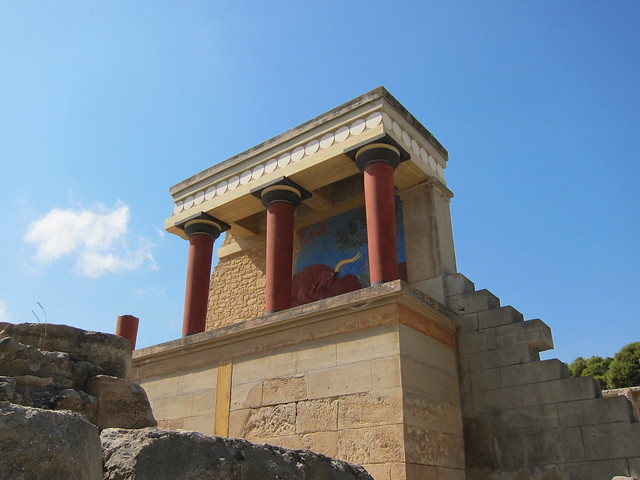
This structure nicely illustrates the controversial steps that Sir Arthur Evans, the main excavator of Knossos, took in preserving the site: he did a lot of rebuilding, and he placed copies of frescoes found on the site in new locations. Apparently, just a few years into the excavation, the ruins were getting badly weathered. Something had to be done to protect them. At Malia, the archaeologists used cement very conservatively, just to cap weathered stones, fill in cracks, or stabilize walls. Evans, on the other hand, protected the ruins at Knossos by (in many places) building cement structures that represented his ideas about what the palace originally looked like on top of them. Obviously, there are several problems with this--most importantly that by doing so he imposed his interpretations on all future visitors to the site. That's not my biggest problem with it, though. From this fresco you can see that what he recreated looks quite a bit like at least one contemporary depiction of the palace.

No, my biggest beef with Evans is that he didn't make his buildings pretty enough. From a distance the modern structures look striking, but up close they're totally cheesy. The fact that they're made completely out of cement is painfully obvious. Parts are cement painted to look like wood. Also, there are metal grates and poles, fences, ropes, and roofs all over the place that are rusted and mildewed and cluttering up the views. I also don't like that some of the areas are fenced off so you can't get a close look.
Despite all this, Knossos is still very cool. Also, the signage is excellent. (There's no signage at Malia.) Here are a few of the most interesting parts.

Amphitheater:
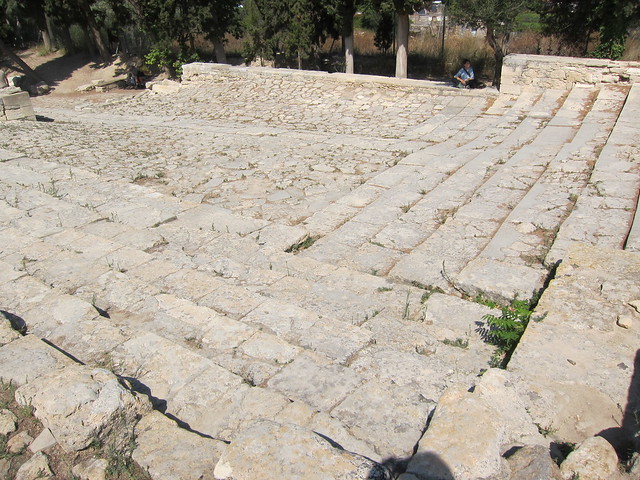
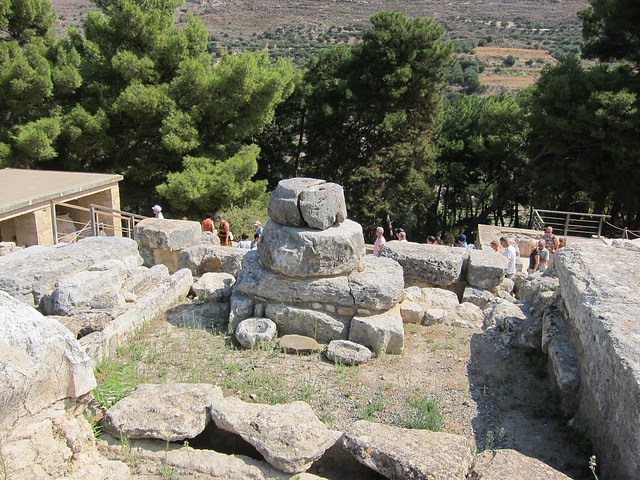
Really large pithoi (urns for storing olive and other foodstuffs):
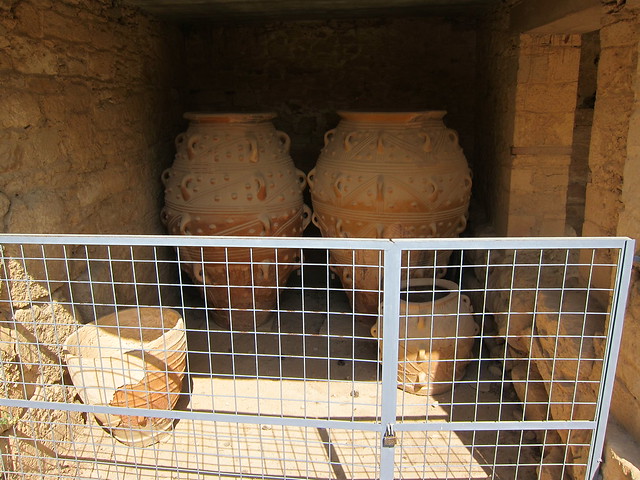
The floor of the throne room (totally original):
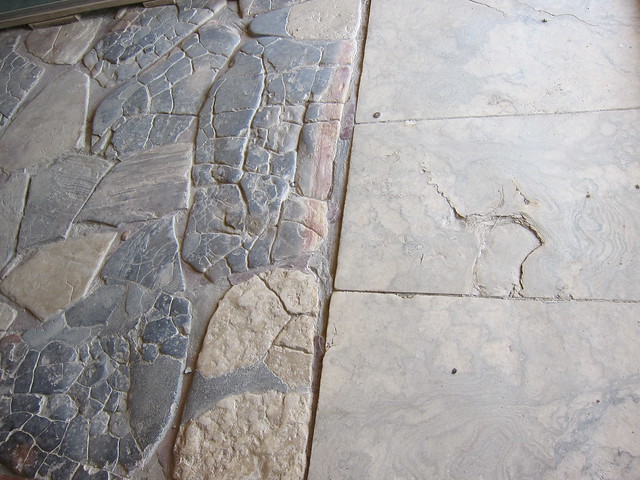
A copy of the throne (the original was alabaster):
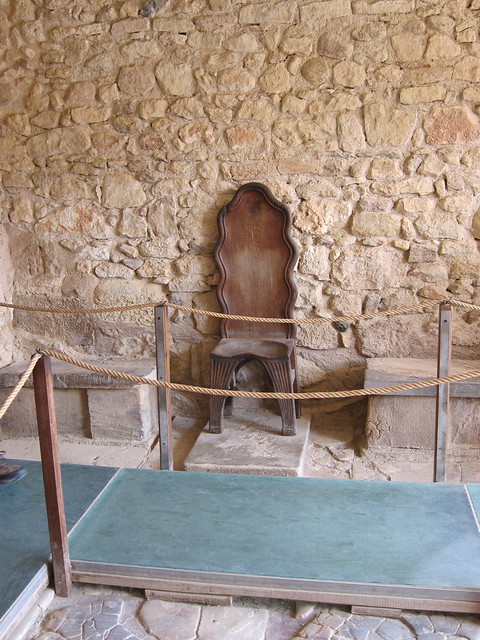
Drainage:
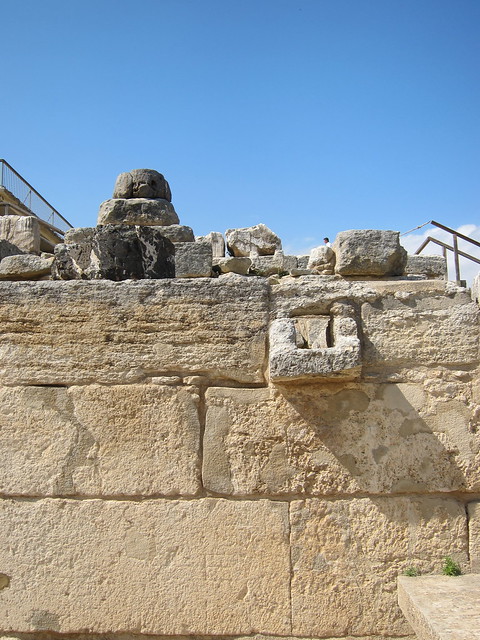
The "Queen's Megaron":
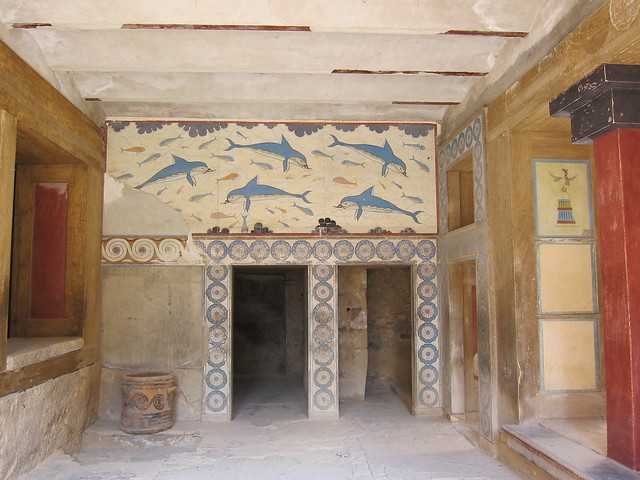
Road leading to the Minoan town nearby:
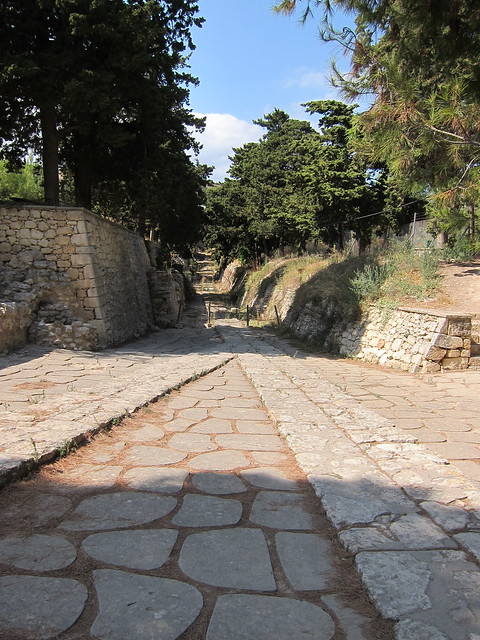
Minoan stuff, although not my favorite part of the trip, was very interesting and totally worth seeing.
One final note:
Before I got to Crete, I thought that the labyrinth in the Minotaur myth was real and had been discovered. Sadly, this is not the case. I overheard a tour guide at Knossos talking about theories on the origin of the myth. First, humans and bulls lived together at Knossos (see above re: bull jumping). Second, the palace itself was labyrinthine--there were over 1500 rooms! So some people, at least, thinks that the palace is the labyrinth. I prefer to think that is still out there somewhere, buried, and someday someone will find it.
On to Santorini! Or back to Crete!
Bizarrely, I recognize and know a number of these artifacts and locales from an Art History class I took at UW. The Queen's Megaron, indeed. It was the low point of my experience at Washington, actually, but how could you know the nightmares you'd trigger with this post?
ReplyDeleteHa ha. Sorry to bring back bad memories. I recognized a few things, too--I think from 6th grade. That was a good year, though, so I don't mind being reminded.
ReplyDelete